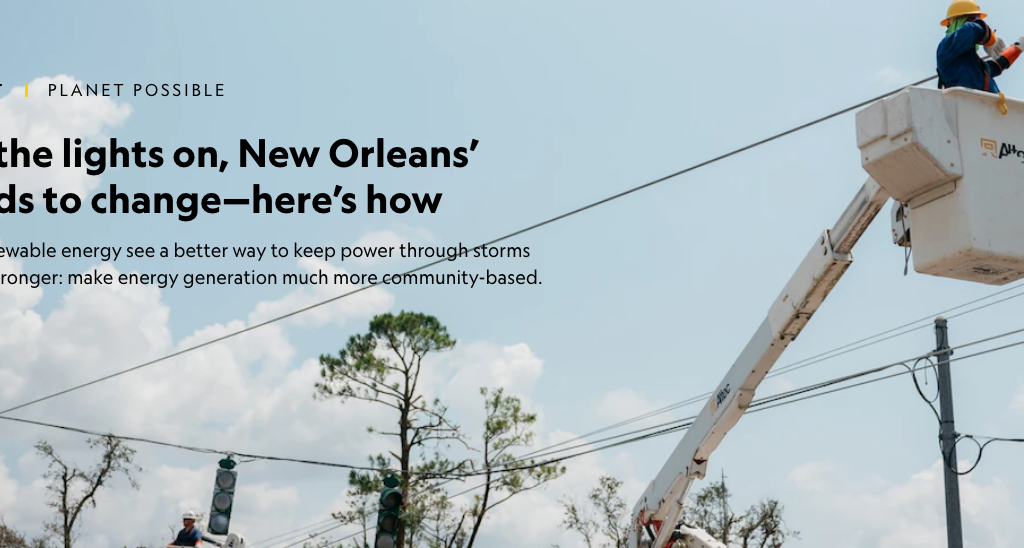To keep the lights on, New Orleans’ grid needs to change – here’s how.

Proponents of renewable energy see a better way to keep power through storms expected to get stronger: make energy generation much more community-based.

Power went out in my New Orleans apartment on Saturday, August 28—the day before Category 4 Hurricane Ida crashed into Port Fourchon on Louisiana’s southern coast, 100 miles away. By Sunday night, more than a million Louisiana households and businesses were without electricity, and the entire city of New Orleans was plunged into darkness. Another 104,000 lacked power in Mississippi. On Monday, residents awoke to “feels like” temperatures that rose into the triple digits without air conditioning, fans, ice, or for many, water.
Tens of thousands of electricity workers from 40 states, with the support of the federal government, fanned out across Mississippi and Louisiana. By September 6, Mississippi’s power had been restored, though the same was true for less than half of those who had lost power in Louisiana, including just 64 percent of New Orleans. The hardest hit areas in Louisiana’s lower southeast could remain dark for weeks yet.
Last Friday, with many homes and entire communities destroyed and still underwater, the area’s largest utility company, Entergy, expressed sympathy for the plight of those still without electricity and reminded customers to avoid “incurring late fees or experiencing service disruption” by paying bills on time and online.


Entergy has come under fire for a host of deficiencies critics contend were avoidable and contributed to the historic loss of power—second only to that in the wake of Hurricane Katrina. Community-based organizations across the Gulf Coast are working to shift the power grid from one based almost exclusively on highly centralized fossil fuels and nuclear power to more localized and equitably distributed renewable energy. Doing that, they contend, will improve service, since smaller systems closer to the end user require less infrastructure to transmit power. The efforts will also contribute to mitigating—rather than adding fuel to—the climate crisis.
Ida carved a path of death and destruction from New Orleans to New York, and advocates say with climate change expected to deliver ever more powerful storms, there is no longer time to waste.
Does this have to happen again?
“No power,” Ida Aronson, a member of the United Houma Nation, texted from Thibodaux in Lafourche Parish on September 6. Having depleted their savings to purchase a diesel generator, Aronson had use of a portable air conditioner, so “we can sleep tonight. Heat has been an issue, thankful it hasn’t rained much past a couple bands, with so many peoples’ roofs off. Houma has a lot more damage, we didn’t want to use the gas to go check my families’ places further down the Bayou, but they did let me know they were safe. Communication has been tough, scary not knowing if my other family and friends are OK.”
Byron Encalade reported a total loss of power in Pointe à la Hache, a predominately Black fishing community in Plaquemines Parish on one of Louisiana’s rapidly disappearing fingers—areas of coastal land so badly eroded that they are quickly disappearing into the Gulf of Mexico, the result of both natural and human factors, including the dredging of canals for the oil and gas industry. Most residents were getting by with small generators from their boats that provided minimal power. Encalade could use his freezer, but not his air conditioner. “I’m sweating it out right now talking to you,” the 68-year-old said.
Critics contend that Entergy has not only failed to adequately adapt its energy model to the climate crisis, including the worsening of storms, it has also fought aggressively against readily available solutions, such as solar power.
ARTICLE CONTINUES
READ THE FULL ARTICLE AND VIEW THE PHOTOGRAPHS HERE ON NATIONAL GEOGRAPHIC’S WEBSITE
